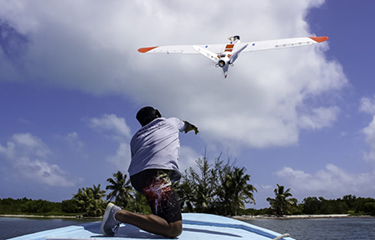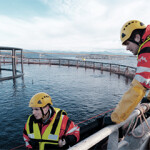Drones fisheries enforcement potential remains untapped, even as projects advance

Unmanned aerial drones have the potential to combat illegal fishing, but are so far rarely used to do so.
From small, commercially-available quadcopters to large fixed-wing drones controlled by artificial intelligence, drones have the capacity to extend the eyes of fisheries enforcement officials farther into the open ocean.
Despite this prospect, there are only a few instances of drones either being used to monitor illegal fishing or being tested for their capacity to do so.
In Belize, drones are used to monitor the Turneffe Marine Protected Area, supplementing small boats patrolling the atoll. And a German security company called Bbcom Secure, recently issued a proposal to use unmanned aerial drones to survey fishing activities from the air. The vehicles would compensate for the disadvantages inherent in using automatic identification systems (AIS) to combat illegal, unreported, and unregulated fishing by monitoring boats directly via video.
In the Seychelles, the FishGuard project aims to pair long range drones with artificial intelligence to allow them to patrol vast expanses of water with only minimal human supervision. First launched in 2018 with USD 150,000 (EUR 134,289) of prize money from the National Geographic Society's Marine Protection Prize, the project is a partnership between Norwegian foundation GRID-Arendal, the Moroccan startup ATLAN Space, and fisheries intelligence not-for-profit Trygg Mat Tracking.
Ultimately, the FishGuard project aims to deter and prevent illegal fishing around small island developing states – which often have only limited resources with which to patrol their huge Exclusive Economic Zones – by improving countries’ enforcement capacity through improved technologies.
The exclusive economic zone of the Seychelles, for instance, is 1.3 million square kilometers, or more than the area of South Africa. Enforcement resources there are limited, allowing illegal fishing to escape unprosecuted, according to Valentin Emelin, who leads GRID-Arendal’s environmental crime program.
"What they currently have is patrol boats, which you can count on the fingers of one or two hands, and that's it. And there may be aircraft, one or two planes, that can do reconnaissance flights or surveillance flights, and that's it," Emelin told SeafoodSource. "Physical control is very difficult."
Even when local fishermen report illegal fishing activity, enforcement authorities often can’t respond in time before perpetrators scurry over the EEZ border, Emelin said. And evidence of infractions collected by local fishermen is often rejected by the courts.
GRID-Arendal is working on both short- and long-range drones. The long range, fixed-wing drones can fly for 10 hours or even a day, taking surveillance and verifying that vessels in the area are fishing legally, cross-checking a database of suspect vessels. Artificial intelligence on the drone will allow it to run those checks automatically, while a land-based operator is on hand to take manual control if needed and inspect the vessel. The drone AI is currently being trained through calibration flights.
"The concept is there. The means are there. But we have not come to this stage where we can say it all works," Emelin said.
Smaller, short-range quadcopter drones launched from Coast Guard vessels and piloted remotely can’t travel as far – only seven to eight kilometers maximum – but they are cheap. Such drones essentially serve to expand the capacity of patrol boats to document illegal activities or warn suspicious vessels via drone-mounted loudspeaker.
"That is a really good solution when they approach the potential violating boat from over the horizon and then they can test it remotely," Emelin said. "You increase your chances of documenting what is going on on board without approaching the vessel itself."
The NGO Sea Shepherd Conservation Society frequently employs small drones from its vessels to identify and document illegal activities and gather intelligence.
Most Sea Shepherd vessels have one or two drones, usually consumer models that are easy to handle on the ship, according to Lukas Erichsen, the information technology manager at Sea Shepherd. The drones can be controlled through radio signals, or can be pre-programmed to fly a certain path.
"It's like extended eyes for the captain," Erichsen told SeafoodSource.
Flying a drone from a fishing vessel out on the open ocean poses significant challenges, from takeoff to navigation to landing – all of which makes it important to use simple, easy-to-operate equipment.
"The ship is rolling so there are a lot of things you have to take care of. You can't just land it on the deck when the ship is mid-roll," Erichsen said. Instead, drone pilots snatch the drones out of the air by hand. "The problem is we're not flying from a lawn. We're flying from a moving vessel, so there's the issue of trying to find your way back again … The ship is bobbing up and down and moving side to side."
Some fishing vessels crews are surprised to see drones observing them, but others are accustomed to it. Only in one case has a Sea Shepherd drone actually been attacked, when poachers shot one down in Mexico’s Gulf of California.
Ultimately, the drones increase observational capacity in a unique way.
"What we use them for, they're super useful. There's no alternative. There's no other way for us to inconspicuously fly by and for people to continue their work," Erichsen said. "If you want to have something like a satellite surveillance, but more real-time and less expensive, then it fills that gap in between."
Photo courtesy of Zoological Society of London






Share